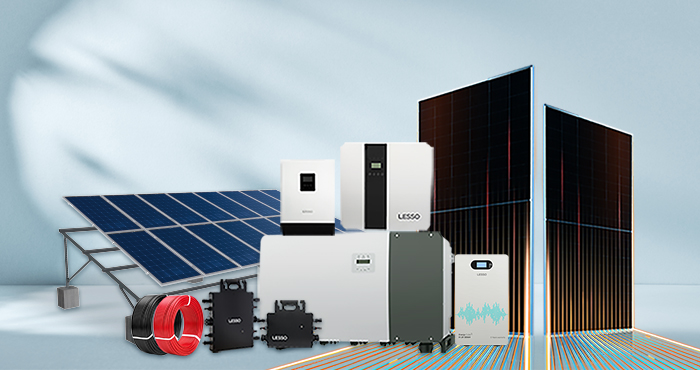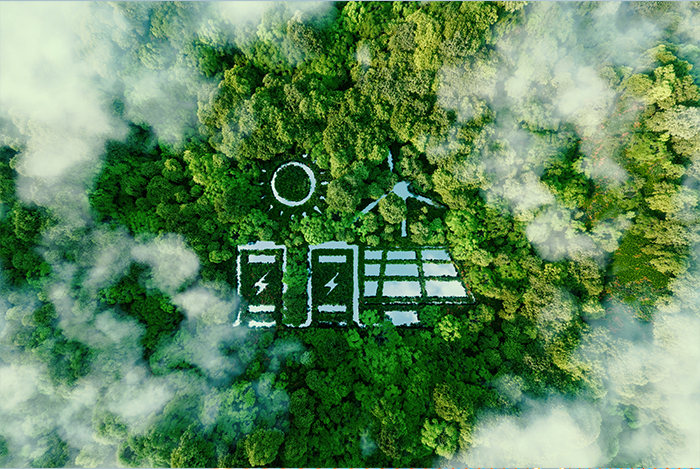
Main Components of Photovoltaic Power Generation System
1. Photovoltaic Modules (Solar Panels)
Photovoltaic modules are the core of the entire system and are usually composed of multiple solar cells connected in series or in parallel. Each cell can convert the absorbed solar energy into electrical energy. The performance, durability and efficiency of photovoltaic modules have a direct impact on the power output and economic return of the entire system.
2. Inverter
The current generated by photovoltaic modules is direct current, while our daily electricity is alternating current. The inverter is responsible for converting direct current into alternating current to meet daily electricity needs. The quality of the inverter is not only related to the efficiency of power conversion, but also affects the stability and safety of the power grid.
3. Bracket system
The bracket system is used to support and fix photovoltaic modules to ensure their stable operation under various weather conditions. The material, design and installation method of the bracket play a key role in the durability and stability of the system. Reasonable bracket system design can effectively protect photovoltaic modules from environmental influences and ensure the long-term and efficient operation of the system.
4. Cables and other auxiliary equipment
The cables play the role of connecting photovoltaic modules, inverters and power grids in the system and are responsible for the transmission of electrical energy. Other auxiliary equipment such as distribution cabinets, monitoring systems and grounding devices ensure the safety and stable operation of the system. Although these devices are not as conspicuous as photovoltaic modules and inverters, they are also indispensable and important parts.
Cost structure and economic efficiency of photovoltaic power generation system
1. Cost structure
The cost of photovoltaic power generation system includes equipment cost, installation cost, land use cost (if applicable), grid access cost and some non-technical costs. Equipment cost is the main part, covering the cost of photovoltaic modules, inverters, bracket systems, cables and other auxiliary equipment. Installation cost includes labor cost and material cost, and the specific amount depends on construction conditions and local labor cost. If it is a centralized photovoltaic project installed on the ground, land cost and grid access cost also need to be considered. In addition, non-technical costs also include pre-development, design, supervision, insurance, acceptance and other costs.
2. Economic analysis
The economic benefits of photovoltaic power generation system are mainly reflected in its power generation income and investment recovery period. The excess electricity generated by the system can be sold to power companies through grid connection, thereby obtaining additional income; in addition, the system can also use its own electricity for self-use, reducing electricity bill expenditure. With the development of the carbon trading market, photovoltaic power generation, as a clean energy, can also participate in carbon trading and obtain additional benefits.
Taking household users as an example, although the initial investment of photovoltaic power generation systems is high, in the long run, the power generation income and electricity bill savings can recover the cost within a few years. For commercial and industrial users, photovoltaic power generation can not only reduce energy costs, but also enhance the environmental image of the company.
Maintenance and maintenance of photovoltaic power generation systems
Although photovoltaic power generation systems are high-tech equipment, their maintenance and maintenance are not complicated. The main maintenance work includes regular cleaning of components, inspection of brackets and infrastructure, planned maintenance of equipment, and preventive testing. Through regular maintenance, the long-term stable operation of the system can be ensured, the life of the equipment can be extended, and the power generation efficiency can be improved.

Summary
As a clean and renewable energy technology, photovoltaic power generation systems are leading us towards a greener and more sustainable future. By mastering the basic principles of photovoltaic power generation systems, we can have a deeper understanding of the value of this green technology and its importance in future development.







